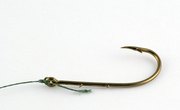Fish will often hang close to a river or stream bank in hopes that insects such as crickets will blow into the water from the vegetation above. Fish will gobble up a stray cricket that has this misfortune in short order. You can use crickets as fishing bait, with the odds being very good that if you can present the insect correctly, species such as trout, crappie and small mouth bass will devour it. Hooking the cricket so that it remains alive and secure on the hook requires the proper technique.
Items you will need
Fishing rod and reel
Fishing hooks
Crickets
Split shot
Hold the cricket gently with your off hand, while grasping the hook in your dominant hand. Refrain from squeezing the cricket so tightly that you injure or kill it as it struggles.
Place the sharp point of the hook into the spot directly to the rear of the cricket's head on its back. Hold the hook so that its shaft is off to one side of the cricket.
Push the point of the hook through the cricket with a steady but easy motion, but avoid pushing it deep into the body of the cricket. Penetrate the hard covering on the cricket's back as little as 1/8 of an inch. By not pushing the point all the way into the cricket, you can keep it alive and moving on the hook when you cast it out, making it even more appealing to hungry fish.
Thread the hook under the back of the cricket and make it come out of the cricket's back. Slide the cricket along the hook so that the cricket attaches to the hook along the bend of the hook between the straight portion of the shaft and the point. The point should not be in the cricket's body.
Impale the cricket on the hook if it finally stops moving to keep it on longer. Run the point of the hook through the length of the cricket's body, starting in its tail and allow the point to come out below the cricket's throat.
Tips
- Use one or two very small split shots to add enough weight to your line so that you can cast it. If you do not add weight, the force you will need to cast the cricket any distance at all will more than likely dislodge the cricket from the hook. Attach the split shots as far as 3 feet up the line from the cricket so that the cricket can float for a short period before submerging.
- An Aberdeen hook is suitable for hooking and fishing with crickets. These light hooks feature a long thin shank. You will have a better chance of keeping your cricket alive longer with this type of hook.
Tips
- Use one or two very small split shots to add enough weight to your line so that you can cast it. If you do not add weight, the force you will need to cast the cricket any distance at all will more than likely dislodge the cricket from the hook. Attach the split shots as far as 3 feet up the line from the cricket so that the cricket can float for a short period before submerging.
- An Aberdeen hook is suitable for hooking and fishing with crickets. These light hooks feature a long thin shank. You will have a better chance of keeping your cricket alive longer with this type of hook.
Writer Bio
John Lindell has written articles for "The Greyhound Review" and various other online publications. A Connecticut native, his work specializes in sports, fishing and nature. Lindell worked in greyhound racing for 25 years.



